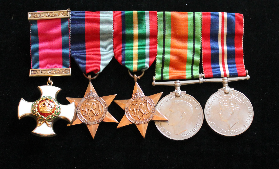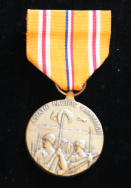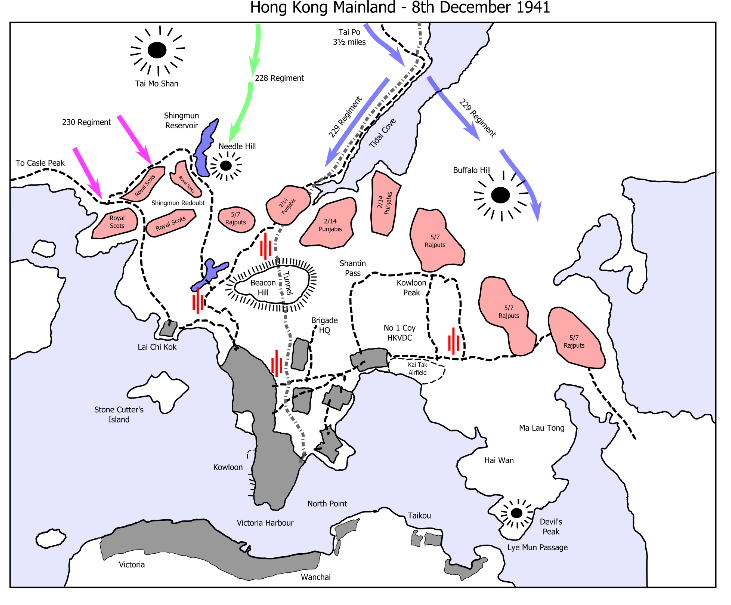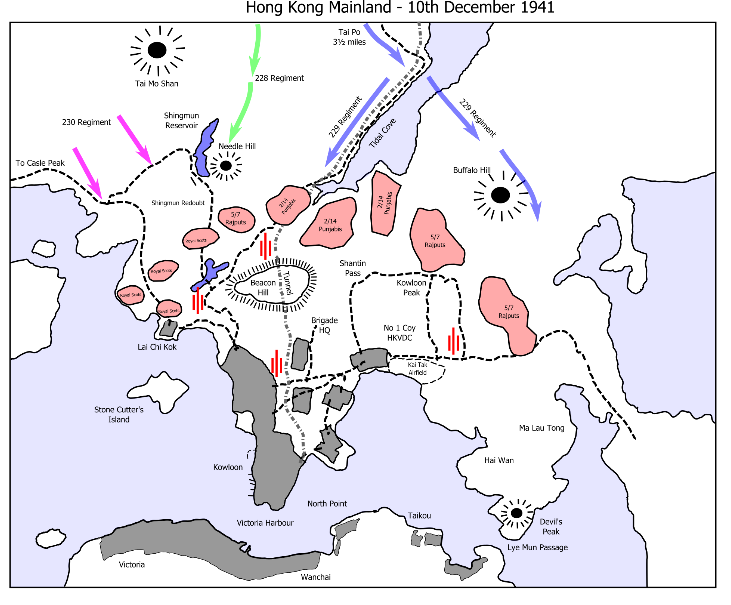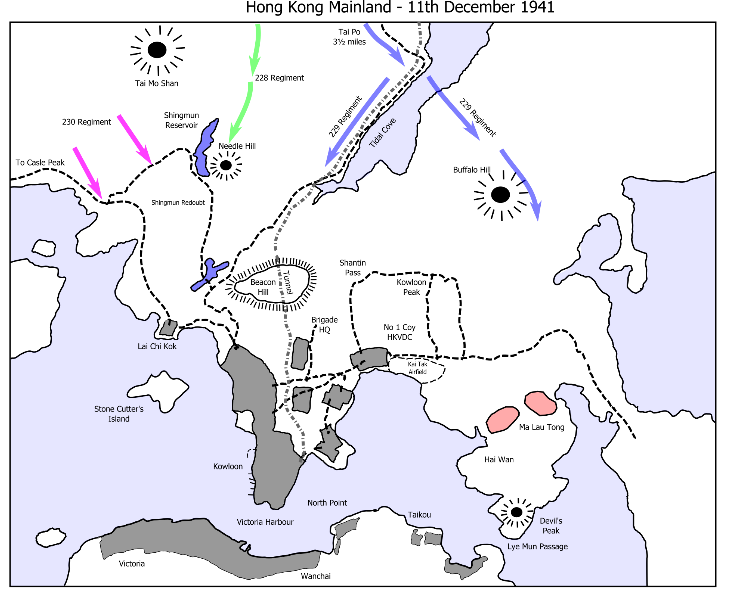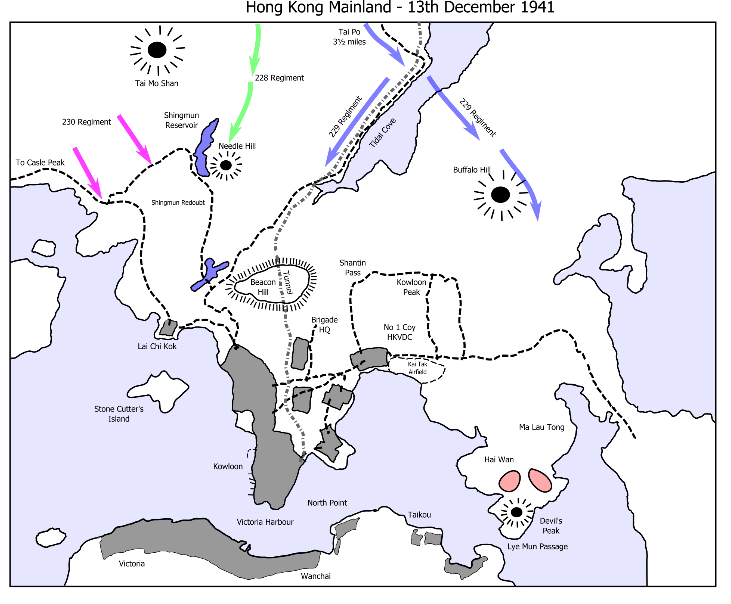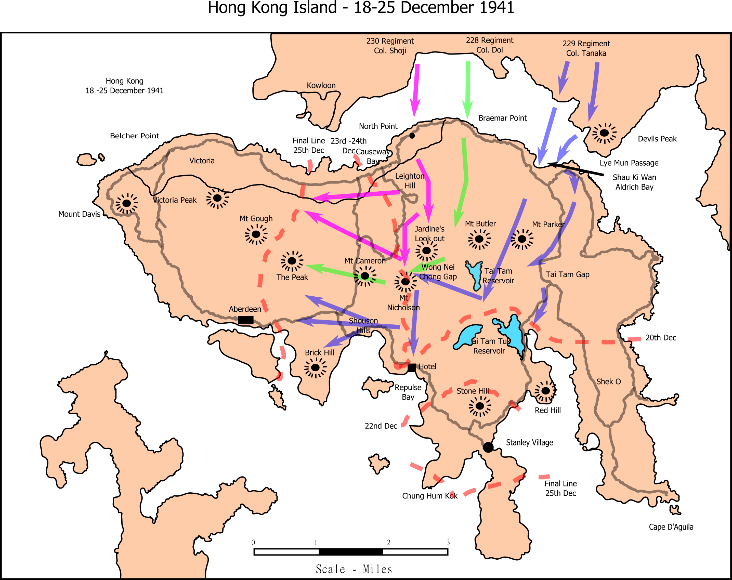The Battle for Hong Kong
December 1941
The following transcription is taken from the news bulletin number 13 of the West of England Medal Club dated 25th September 1985.
It recounts the battle of Hong Kong from the point of Mr John ‘Douglas’ Bertram and Major Cecil Robert Templer (at the time of the bulletin he was Brigadier)
Mr Douglas Bertram, our first speaker must have spent many hours preparing the magnificent maps he brought along, so as to emphasis his talk, enabling members to follow quite easily the battle areas he referred to. The main central map has been coloured to show up as a particular the ridges, valleys, inlets and hills and this was complemented by several smaller maps upon a particular field of activity.
By referring back and forth to the main map he was able to give a very vivid picture of the terrible conflict from the 8th to 20th December 1941, which covers his part of the story.
In September 1939 the Japanese demanded the withdrawal of all foreign troops from China. Japan’s general strategy was to cripple the United States Pacific Fleet, seize the South East Asian colonial territories by a series of lightning campaigns and then organise its defence strongly enough to ensure the ultimate acceptance by the United States and her allies of its absorption into the Japanese sphere through a compromise peace.
The plan adopted was for a simultaneous attack on the seventh and eighth of December, on Pearl Harbor, Hong Kong, the Philippines and Malay. In 1941 was the blackest period of the war for Britain and her allies with surprise being the essential factor for Japan. The speed with which the onslaught was made therefore, gave them an additional advantage.
Douglas began his story by giving a brief history of the Crown Colony of Hong Kong, consisting of the island of Victoria, the mainland of Kowloon and the New Territories. Victoria was ceded to Britain by the Treaty of Nanking in 1842, covering 32 miles, with a chain of mountain ridges throughout its 11 mile length. Kowloon Peninsula, ceded to Britain by the Convention of Peking 1860 and the New Territories leased for 99 years in 1898. The frontier runs along the Shum Chun River with the crossing point at Lowu on the British side, and the Shum Chun on the other. Two roads connected Taipo, meeting at Fanling then on to the border. The mainland was mountainous covered by forests of fir trees, bamboo and scrub. The only aerodrome was at Kai Tak, East of Kowloon, and the Chinese population being Hakkas, Tankas, Hoklas and Puntis. In 1941 the governor was Sir Mark Young and the General Officer Commanding, Major General Maltby MC. The plan for the defence of the colony was for the main brigade, under Brig. C Wallace to hold Gindrinkers Line for about a week, falling back to the Ma Lau Tong line on the Devil’s Peak Peninsular, and then withdrawing to the Island. The maps below, provided by Douglas, will help you to follow the stages of the battle.
On Sunday, December 7, 32 of the 36 merchant ships in the harbour left at 11am. A general stand-to was ordered and by 6pm that night all troops were in their battle positions with “C” Company 2/14 Punjab Regiment under Maj. Gray with two armoured cars HKVDC at Fanling and patrols of the Royal Scots in the vicinity of Au Taw on the Castle Peak Road. Monday the eighth, at Fortress headquarters major boxer picked up her Japanese broadcast at 04.45 that the war was imminent. At 06.45 message was received from Singapore that Japanese troops had landed in Northern Malaya. Within minutes of this message, the Hong Kong Volunteer Engineers and a Second Lieutenant Tamworth had blown the border bridges at Lo Wu. At 07:30 hours the Japs crossed the border. The forward troops at the Fanling slowly fell back, demolishing each bridge as they crossed. On the Castle Peak Road the four Bren carriers of number one company Hong Kong volunteers under Second Lieutenant Edwards and the Royal Scots patrols fell back towards Gindrinkers Line demolishing the bridges as they went.
At 08:00 hours that morning 36 Jack bombers and fighters attacked Kai Tak airfield and Shamsuipo barracks. At 15:00 hours Major Gray decided to make a stand at Taipo. A Japanese battalion with a Pack Battery on mules came out of the hills and was allowed to get within 300 yards before firing was opened. The Japanese suffered heavy casualties and the Pack Battery was dispatched into the blue. At 18:30 hours the Afridi Platoon under Jemadar Sherin Khan ambushed a hundred Japanese crossing the golf course. Another Japanese platoon was ambushed and wiped out in the cutting, by Second Lt Crothers’ armoured cars and by midnight the forward troops were at Taipo Mei.
On Tuesday 9th, soon after midnight, the Japs started to outflank the Punjabis who began to withdraw to a defensive position in the Tau Fung Shan Monastery Ridge. This position was held all day until 18:00 hours when they withdrew behind the Gindrinkers Line. The reserve company (“D” company - Capt Newton) 5/7 Rajputs were moved from the right flank to fill a gap between the Royal Scots and the Punjabis.
At 15:00 hours the Japanese forward troops were on Needle Hill opposite the Shingmun Redoubt. At 23:00 hours, two companies of the Japanese third Battalion 228 Regiment (Col Doi) attacked the Redoubt and by just after midnight it was in their hands, the Royal Scots having fled in disorder, getting the name “FLEET OF FOOT” instead of the 1st of Foot. The second in command, Maj Burns, committed suicide, the loss of this position was a disaster. In the early hours of Wednesday, December 10, the reserve company Winnipeg Grenadiers, was brought over from Hong Kong Island and dug in at the junction of the Castle Peak and Taipo Road.
At 09:30 hours the Japs pushed forward from the redoubt but were driven back in disorder by Capt Newton’s “D” Company of Rajput’s. Heavy artillery fire was brought down on the Redoubt by the guns of H.K.S.R.A. but at 12:00 hours the Japs again attacked “D” Company Rajputs and “A” and “D” companies Royal Scots. They were however repulsed. HMS Cicala which was shelling the Japanese advance on the Castle Peak Road was attacked at 16:15 hours by Japanese aircraft and was damaged.
During the night the 10th “B” and “C” companies of the Royal Scots pulled back to a new line - Shingmun Reservoir, Golden Hill, Lai Chi Kok.
On December 11 the Japs attacked at dawn the Golden Hill position. It was a full blooded “Banzai” attack which by 07:00 hours gave them possession of the hill. The two company commanders and 60 Royal Scots were killed. They fell back in ignoble confusion. Total disaster was averted by a fierce counter-attack by Capt Pinkerton’s “D” company. They recaptured the hill long enough for the remainder of the Royal Scots to sort themselves out. The Bren Carriers and armoured cars of the Hong Kong Volunteers rushed along the Castle Peak Road and stabilise the position.
The Winnipeg Grenadiers were brought forward to Lai Chi Kok and came under artillery fire, making them the first Canadian troops in action in the 1939-45 war. At midday orders were given for the withdrawal to the island that night. Before midnight, the Royal Scots, Winnipeg Grenadiers and the H.K.V.D.C. carriers and armoured cars withdrew to Kowloon and were ferried over to the island. The Punjabis and the Rajput’s withdrew across the Japanese front via and Shatin and Grasscutters Pass to the Ma Lau Tong line on the Devil’s Peak Peninsular.
On Friday 12th December, there were many air raids during the day on the island and late in the afternoon the Japs port on another mast “Banzai” attack against the Left Company of Rajput’s. This was repulsed with heavy losses and at 09:30 hours a further withdrawals made to the Hai Wan line held by HQ Company Rajputs.
At 01:30 hours on Saturday, December 13 the last 300 Punjabis were evacuated and at 04:00 hours the Mountain Battery of four guns and a company of Rajputs left. It was decided that all troops would leave the mainland by 08:00 hours. This was done by HMS Thracian and for motor torpedo boats coming close inshore and taking the last troops away. The Japs were reluctant to follow up after their heavy casualties the day before. At 09:00 hours a Japanese peace mission came across the harbour to Victoria Pier with terms for surrender. These were rejected. The Japanese shelling on the island continued on Sunday, December 14.
The 2×4.7 inch guns at Belcher Point and the anti-aircraft guns on Mount Davies were knocked out.
During the night of Monday the 15th HMS Thracien sailed down the harbour and sank two Japs ships and set another on fire. These were full of troops. At 21:15 hours the Japanese attempted landing across the Lye Mun Pass which was repulsed. All the enemy craft were sunk and the Japs Company either killed or drowned. This being done by the 6 inch guns at Pam Sha Wam under Master Gunner Cousins and rifle and machine-gun fire from No. 2 Platoon Royal rifles of Canada. On Tuesday the 16th there was hell of heavy shelling of the North Shore and the air raids on Mount Davies, Shek O, Lye Mun and Aberdeen, where HMS Thracian received a direct hit. At dawn on the 17th there was a mass air raid followed by another peace mission under a “flag of truce”. Hostilities was suspended till 16:00 hours. The surrender terms were again rejected. Thursday the 18th saw heavy shelling and mortaring of the North Shore from North Point eastwards. At 20:30 hours the Japs landed on the island and a front from North point to Lye Mun. The night was very dark and overcast with showers of rain and smoke from the burning oil tanks at Northpoint and the paint factory at Braemar covered the area.
Three separate landings were made:
229 Regiment Col Tanaka at Shau ki wan and Aldrich Bay, to take Sai Wan and Lye Mun, then force their way into the Taitam Valley either over Mount Parker or via Quarry Gap.
228 Regiment Col Doi landed a Braemar, secured the bridgehead then pushed up Mount Butler.
230 Regiment Col Shoji landed at Northpoint split in twointo groups and moved inland towards Jardine’s Lookout and Wong Nei Chung Gap.
The Rajput’s fiercely resisted the Japs, most of “D” company including Capt Newton, being killed. At Northpoint power station, 68 Hong Kong volunteers with two Middlesex Regiment machine guns plus the Hughe’s Group (19 men - some of whom had served in the Boer War, the elders, private Sir Henry de Voeux, being 77) held two company of Japs at bay until after 16:00 hours on Friday the 19th. It has been described as one of the finest actions of the campaign. By dawn on Friday, the Japs had 7500 men ashore. They pushed on towards Wong Nei Chong Gap and Stanley. There were many gallant actions at Jardine’s Lookout, Mount Butler (where and CSM Osborne got a VC) and Quarry Gap etc., these were stories on their own, a case of platoons and less, against Companies and even Battalions of Japs. By the morning of the 20th the line ran from the Causeway Bay in the north, to the Wong Nei Chong Gap in the centre, to Repulse Bay in the south, then the East Tai Tam Tuk Reservoir.
The British troops involved were:
8th Coast Regiment Royal Artillery
12th Coast Regiment Royal Artillery
5th Anti-Aircraft Regiment Royal Artillery
965th Det. Bty. Royal Artillery
1st Regiment Hong Kong & S.R.A
22nd Field Coy. Royal Engineers
40th Field Coy. Royal Engineers
Royal Rifles of Canada
Winnipeg Grenadiers
2nd Royal Scots
1st Middlesex Regiment
2/14 Punjabis
H.K.V.D.C (Hong Kong Volunteer Defence Corp)
[H.K.S.R.A. (Hong Kong & Singapore Royal Artillery)]
(5 Batteries of Artillery and 7 Infantry Companies)
Hong Kong Mule Corp
Royal Signals
Royal Army Ordinance Corp
Royal Army Service Corp
Royal Army Veterinary Corp
Royal Army Dentistry Corp
Royal Indian Army Service Corp
Royal Army Pay Corp
IMS (Imperial Munitions Service?)
Total 541 officers and 10,778 Other Ranks
The Japanese forces were:
CinC – Lt General Sakai
38 Div – Maj. Gen Sano
Infantry Commander – Gen. Ito Takeo
228 Regiment – Col. Doi
229 Regiment – Col. Tanaka
230 Regiment – Col. Shoji
14th Heavy Artillery Regiment
38th Mounted Artillery Regiment (3 Battalions)
2nd and 5th Independent Anti-tank Regiment
Independent Mountain Artillery Regiment
21st Motor Battalion
38th Engineer Regiment
Independent Engineer Regiment (2 Eng. Units : 1 Landing Craft Unit)
Also …. ATT. 66 Regiment - Col Suzukawa (3 Battalions)
Armoured Unit (Light Tanks)
Total: 20,000 men
Reserve Divisions:
51st Division – 20,000 men
104th Division - 20,000 men
TOTAL: 60,000 men
Each Regiment had 3 Battalions
A Battalion had:
H.Q. Company
Machine Gun & Motor Company
Four Rifle Companies
(1,100 men)
Douglas Bertram’s father served with the Hong Kong volunteers and was badly injured during the battle. From hospital he was repatriated to Australia, but died shortly afterwards. Douglas’s mother had been informed he was to be sent home to England with other troops, and left Australia immediately to be with him. As they were sailing for England, Douglas’s father was on his way to Australia.
The next part of the talk was carried out by Brig Cecil Templer.
From Saturday 20th December 1941. Cecil gave a brief description of the actual West Brigade (although he himself was concern with the Ease Brigade), they been the larger force, made up from the remains of five battalions. The people who were actually in the front line however, were not more than 1500 men, opposed by 6 battalions of Japs (6000), so they did not have much of a hope. It was a very disorganised affair because the Brigade Commander, a Canadian, was killed when Wong Nei Chong Gap was captured and his successor, Col. Rose of the Volunteers, never really got a grip of things. It was a beastly old battle of Companies, even Platoons, against the overwhelming force of the Japanese who attacked line upon line. As the Brigade were mown down another line came on, because they had two Divisions, with a backup Division behind, making it hope a hopeless battle for the West Brigade.
At this juncture, Douglas at the request of the Brigadier, showed and select the 25th which was the Last Line. Reminding members of the various positions of the regiments, the Brigadier emphasised it was a battle of Companies and Platoons and said he would like to give a short description of three of them. There was “Z” company of the Middlesex, who held out on Leighton Hill for three days as the Japs passed by and then escaped getting back to the lines (“Z” company were mainly Bandsmen, with the odd few Volunteers,) and as the Bandsman’s were normally only trained as Stretcher Bearers. The second company was “A” company Punjabis. They were down on the south of the island and their Commanding Officer Col Kidd tried to mount an attack on Shouson Hill. This they did supported by the fire of the gunboat Cicala but did not get very far, as all were killed, including the Commanding Officer. Close-by Brick Hill was held by a party of the Middlesex Regiment for two days, but they eventually surrendered. After the battle, someone passing along the way, found all the Middlesex with their hands tied behind them. All had been decapitated. The Brigadier then referred to Major Dewar who was he said, a very remarkable chap; on the evacuation of the Indian infantry across the Lye Mun Pass, he had a ferry, and although all the Chinese crew had deserted, he ran the ferry himself under direct Japs fire arriving at Shouson Hill with 20 to 30 volunteers, which he held until the surrender. An interesting point was, he had been a Gunner in his earlier life and he brought down fire from the Stanley coastal defence guns, 9.2 inch guns firing 380 pound shells – range 10 miles, on the civil lines which was still open.
The Brigadier then went on to talk about his own part in the defence. At the time he held the rank of Major with 30 Battalion of the 9.2 inch Coast Defence Guns on Cape D’Aguila, and on 17 December, very nearly succeeding in the sinking of a Jap Cruiser. Owing to the Jap advance on the island after their landing, the 9.2 inch guns were destroyed and the battery withdrew to Stanley Peninsular on the 19th. The whole of the north eastern end was in enemy hands. During the withdrawal to Stanley the dial sights and ammunition of the guns of the 1st Mountain Battery had been thrown away on the north side of Red Hill. Major Templer, with Sgt. Hanger of I.M.B. (Imperial Munitions Board?), went back to retrieve them. Japs appeared close by and Sgt. Hanger was shot dead. The Japs sniper being under the impression the sergeant was the officer, as he was carrying a revolver, Major Templer, a rifle. It was a lucky escape for our President, but not for the unfortunate sergeant.
At 17:00 hours on 21st of December, Brig Wallace ordered Major Templer to go to the Repulse Bay Hotel and take command of all troops in the area. Doing his best to sort out the men of about six units around the hotel, he mounted a counter-attack towards Wong Nei Chong Gap with Major Young’s “A” Company, Royal Rifles of Canada. As he left the hotel, Jap machine gun fire punctured the radiator of his car and the tyres. He got into a Canadian truck which was up the road towards Wong Nei Chong Gap, passing a royal naval party which had been ambushed. The gap was held by two battalions of Col. Dois’ 228th Regiment, and it was getting dark as he put the two light machine guns out on a flank to give covering fire. The Canadians were not very enthusiastic reporting that the light machine gun had jammed. He withdrew, leaving the Canadians at Altemira House, and taking a cycle, along with Bombardier Guy, cycled back to the Hotel.
On 22nd of December, Lieut. Prophet and his Volunteer Platoon occupied the spur overlooking the Hotel. It was decided to withdraw all troops from the Hotel back to Stanley. About 20:00 hours, lights was seen in one of the rooms in the north wing – a Jap patrol had entered. Major Templer, Bombardier Guy and a few others went to investigate. Hearing the Japs at the other end of the corridor, he bowled a number of grenades down it, whereupon the Japs departed. When the moon set, Major Templer took the troops out of the Hotel – boots round their neck, through a side entrance, down to the beach and along a very rough track to Stanley. The end of the defence of Repulse Bay lasted 72 hours.
By 24th of December, the Japs were intending to break through the defences of Stanley Isthmus at Stanley village, held by Maj. Forsyth H.K.V.D.C., with East of the Village – Stanley Platoon H.K.V.D.C. (Lieut. Fitzgerald) and a section of the Middlesex machine Gunners, Capt. Weedon’s company of Middlesex and part of “A” company Royal rifles of Canada. The Japs had to reserve battalions, 1/229 Regiment and 1/230 Regiment with a new regiment of two battalions of the 66th Regiment, with some light tanks. The attack developed at 20:50 hours. In the meantime, at the Prep School, Major Templer and Capt. Weedon were forming another line of defence. Whilst he was phoning inside the pumping station, a mortar bomb burst outside the door, shrapnel going underneath and wounding Major Templer very severely in the legs. He said, there was a vivid explosion, and when he came to he found himself covered in blood, that was the end of the war for him.
Hong Kong surrendered at 16:43 hours on December 25th Stanley finally surrendered at 00:45 hours on December 26th. It was for his remarkable efforts during the Battle for Hong Kong our President was awarded the D.S.O.
[Small changes have been made to the text, so as to clarify certain points, but I hope that I have made no significant changes/mistakes. In some cases I have expanded military abbreviations for clarity. The drawings have been reconstructed from the black-and-white photocopies. Some of this is conjecture but for the Battle of Hong Kong Island, I have referred to the drawings from the Wikipedia article mentioned at the end. Additional place names have been added so as to clarify the text. – AST Apr 2020]
This account is very similar to the account told in Wikipedia but naturally from the perspective of Major Templer and Douglas Bertrum.
Further reading:
https://en.wikipedia.org/wiki/Battle_of_Hong_Kong
http://battle-of-hong-kong.wikispaces.com/
http://www.britain-at-war.org.uk/ww2/Hong_Kong/html/stanley_barracks.htm
It is my understanding that Major Templer was held as a Prisoner of War in Hong Kong for the duration of the war and worked as a Camp ‘cobbler’. Before the invasion, his wife Angela and his three very young children, James, Ann and Jennifer were despatched by ship from Hong Kong, but were captured by the Japanese in the Philippines, were they remained until, their camp was liberated by the Americans in 1945. Angela was honoured by the Americans by being award their Asiatic Pacific Campaign medal, one of only a few British Subjects to be awarded it. Both Cecil and Angela spent their time in POW camps, never knowing if the other (or the children) were alive.
